Short story
The painter without signature
This year won’t be about grades. I rather get a C from him than an A splashing out paint, Cesar thought on the way to the painting class audition. Last year, two students dropped out during the first month. Cesar knew they were remarkably talented, so he was wondering if they were poisoned by grades prestige.
In the line to the audition, he noticed the gal in front didn’t bring student‑grade oils, but Olholla ones.
“Melissa, make sure you don’t over saturate the skin,” he said.
“Envy,” she responded without turning her head.
He had always wanted to paint with them, so he wondered: Is this envy?
“Melissa, he’s right. I wouldn’t use them,” said another student.
That’s en…! Cesar thought in relief. Someday I’ll understand why some people don’t want others to have good things.
In the classroom, only moving chairs could be heard. The easels were arranged in an arc, and in the middle there was a girl in a Chinese dress ready to pose.
Is this the big secret test? A live portrait of a girl? No poses; no wrinkles? he thought not realizing that even the rejected candidates didn’t say what happened in the audition.
He prepared his brushes and took a quick look at the girl, which reminded him of rule number one: don’t make a kid stay still for long. The light… Is it too bright for her? he thought while carefully looking at her eyes. After seeing no hint of discomfort, he wondered: Who is this girl?
When he was about to pick up his paint tray, the teacher stood up from his desk and gave each student a piece of paper and a pencil, but no eraser. Cesar looked at Maria and their faces said: One mistake and we are out.
The teacher walked up to the girl. Then, palm up, slowly raised his arm and pointed to her face. Cesar took a deep breath and thought: Showtime! He was no longer worried about making a mistake. He sketched her like a master, not with his wrist but with his arm. In no time, he had blocked out a well‑proportioned face and finished the drawing in two minutes.
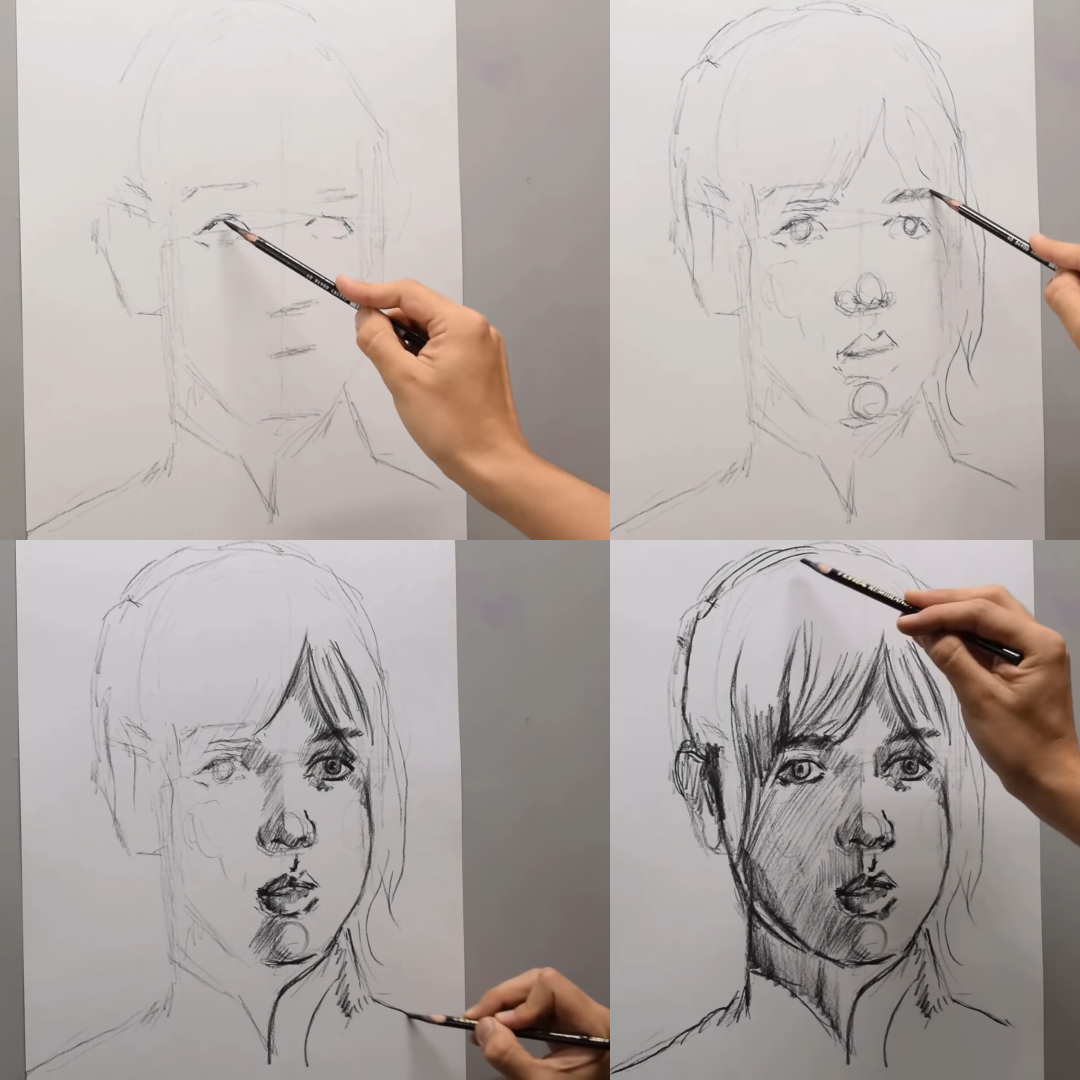
The teacher silently walked behind the easels, and when he saw that Cesar had finished drawing, he told him: “Do it again. Here’s a rag.”
Cesar made a concerted effort not to say or make any gestures. He remembered: I’m here to show him what I’ve got.
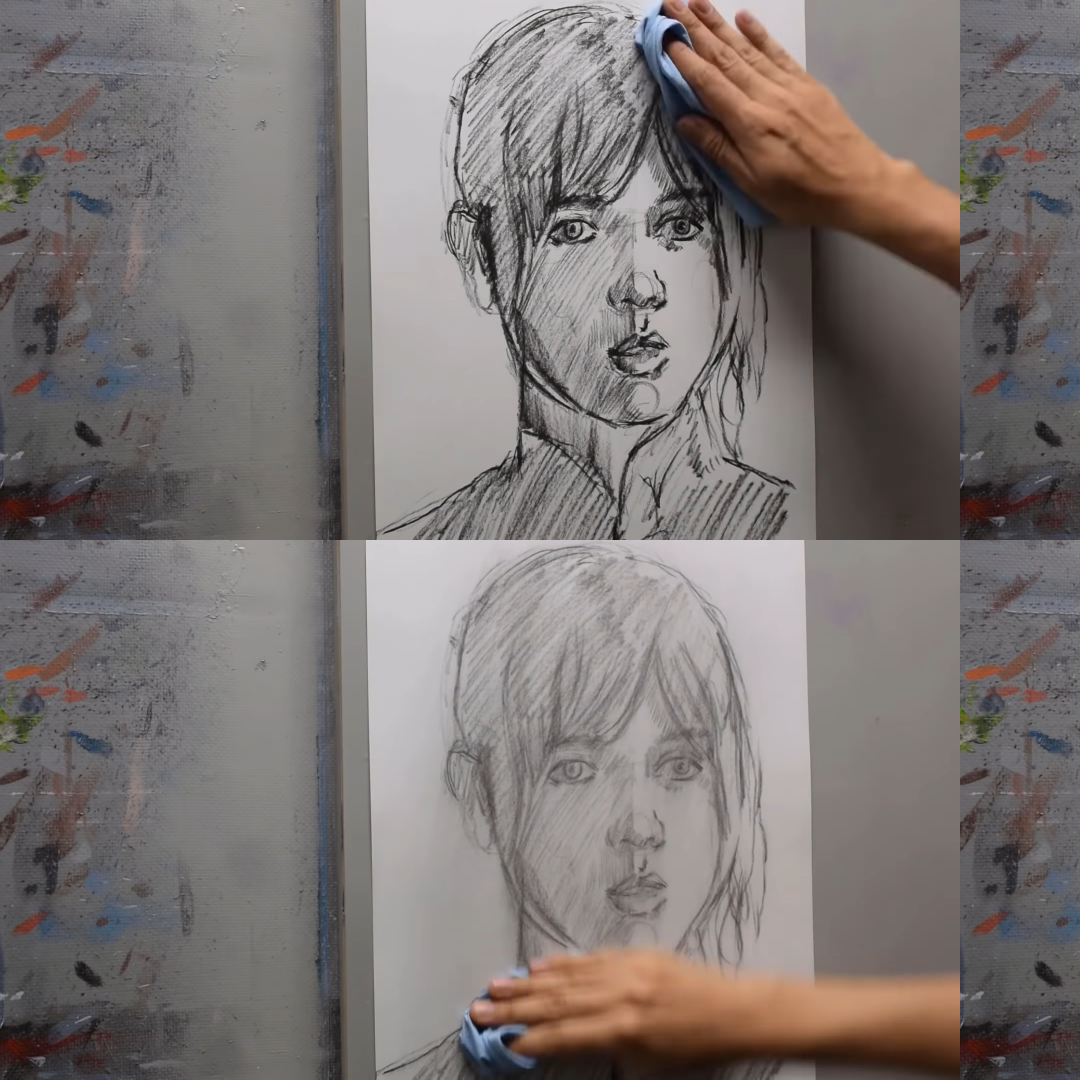
While wiping off the drawing, Cesar noticed her eyes and lower lip were off. That’s the problem, he thought – not in frustration but in satisfaction. Not the satisfaction of having found a way to improve, but of having it already fixed. To him, spotting a bad form and correcting it were parts of an inseparable phenomenon, like oxygen and fuel for a fire.
Ready to fix it, he grabbed an eighty‑grit sandpaper from his bag and rolled the pencil on it until the pencil had a long and sharp tip.

When he finished drawing her, the teacher looked at him and made a small circle in the air with his index finger. Cesar quickly wiped off the drawing again.
Well, he must not be liking my hatching; let me shade it instead, he thought. So this time he blended the charcoal with his finger.

Cesar noticed that the more details he added the muddier the drawing became. He stopped drawing. I’m out. The simplest portrait and I botched it, he thought.
When the teacher took a look at the drawing, Cesar tried to look into his eyes for any hint of expression, but it was too late; he had started walking to his desk.
The teacher went back to Cesar and gave him a kneaded eraser and an eraser pencil. “Pull out the highlights,” the teacher said. Cesar smiled for the first time in that room.
He started bringing out the eyes’ reflection. Then he tackled some midtones and ended up with the rim light on her ear. He moved back to see the full portrait, and he was amazed to see himself rendering such a realistic result.
I didn’t draw beauty, I uncovered it, he thought. He imagined the great Michelangelo Buonarroti chiseling out the finest marble and made a pact with him: Yes, knowing what to remove is important.
He looked at the drawing one more time, and although he knew it was good, he didn’t sign it. He secretly wanted the teacher to tell him to do so.
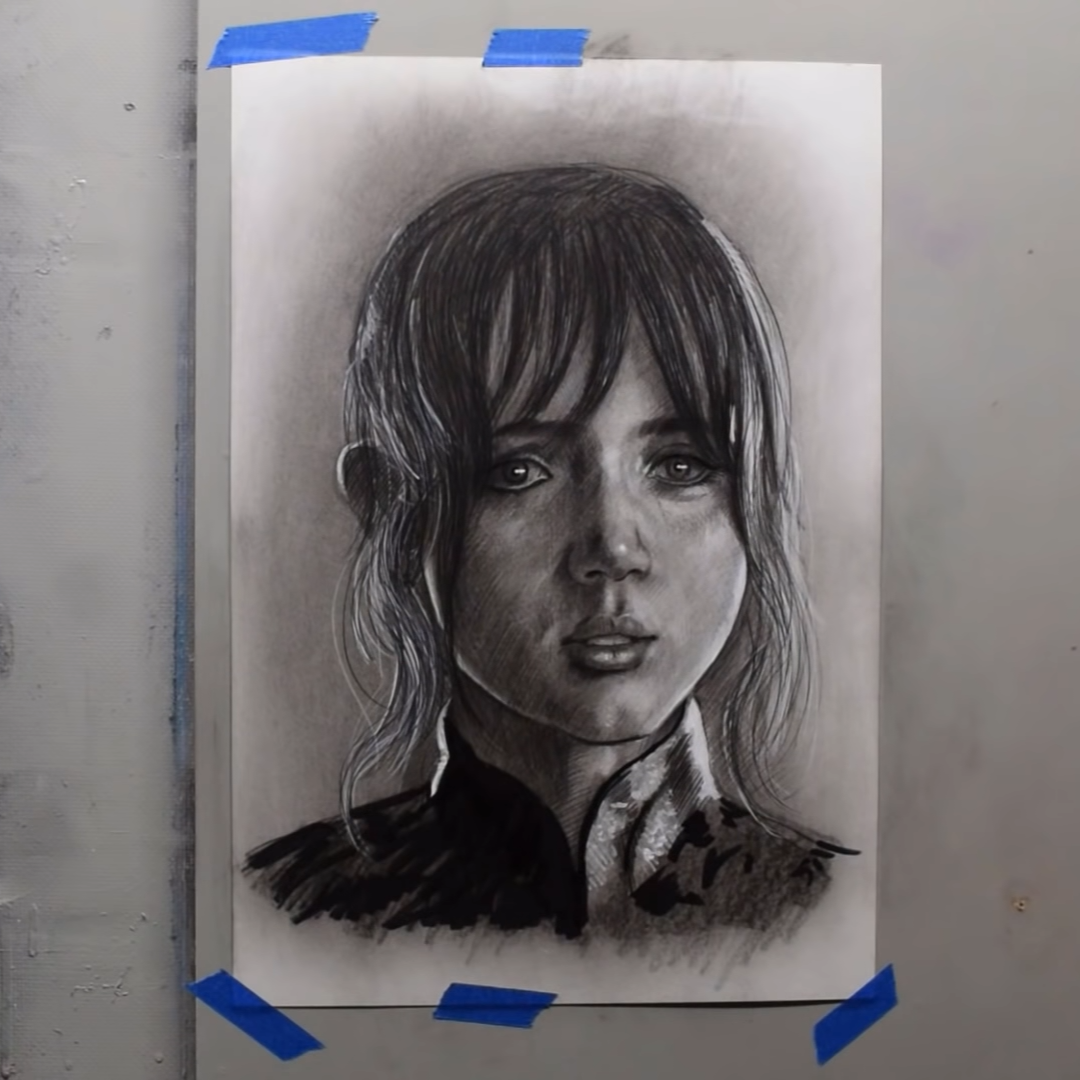
While waiting for the teacher, he looked at the other candidates. They were amazed by their results as well, and they were leaving the classroom looking at their pieces with great pride. The pride he could only bet on this teacher’s approval.
Finally, the teacher came by his easel, took a quick look and calmly told him: “Tear it up.” Cesar’s disappointment made him move his head down, but he sharply straightened it up as if he had intended to nod. While the teacher left, he thought: Today, besides controlling my hand, I need to control my whole body. Today, I’m an artist but also a soldier.
Without thinking more, he tore up his drawing. When the teacher heard that straight cut, he turned around and told him: “Bring your brushes on Monday. I will teach you painting.”
Cesar woke up on Monday ready for his first day of class. It was far from any other first day. He felt as if he had known the teacher for years.
He arrived early, and to his surprise, the teacher was already there. Moreover, he was welcoming each student with a warm good morning.
Cesar was wondering if the teacher had been cold on purpose during the audition or if he was like that in class. Maybe it was a bad day, and today he’s fine, was his last thought.
“Welcome, ladies and gentlemen. Today we are going to continue with last week’s lesson. No, I’m not going to ask you to tear up your paintings.” He paused for a collective sigh. “Today, you’ll paint with water.”
“Watercolor…” said a student.
“Water. You’ll paint anything you want with plain water.”
Cesar took a brush and started painting steady horizontal lines from the bottom edge up to the lower third of that dark canvas. Then, he painted a big Sun setting down on the horizon. He paused to think about how he would have mixed its color. Like a musician with perfect pitch, Cesar could call out the exact amounts of paint to make any color. When he finished mixing it in his mind, he noticed that the horizon line started to dry out, and he heard: “Keep painting. Keep painting.” He couldn’t tell if he imagined it or if the teacher said it.
“Notice the difference?” the teacher asked the watercolor student.
“Yes, it vanishes out.”
“Notice the difference?” he asked Cesar, who said nothing at first.
The answer must be the lesson, Cesar thought. Subconsciously, his focus went from his painting to himself painting. My arm is not rigid, he felt. “I’m painting more relaxed, sir.”
“That’s close, but keep painting.”
Right, tearing up the drawing wasn’t relaxing at all. Why do I trust this man? Of course, his paintings. Trust him, keep painting.
A student snapped with satisfaction: “Sir, results don’t matter.” The teacher quickly replied: “They matter.” His tone added: don’t forget it.
When the time was up, Cesar looked around and the student next to him was painting a circle over and over. Cesar couldn’t stop imagining him drilling a hole through the canvas.
Cesar thought: Patience! That’s it. Patience is the lesson. Wait. I mean tolerance. Patience — water. Tolerance — tearing up the drawing. But that can’t be; he’s an art teacher, not my mom. Walking back home, he kept repeating to himself: erasing; tearing it up; painting with water.
At home, Cesar he kept painting and watched every single stroke disappear. His mom asked: “Do you need money? That’s the cheapest paint I’ve ever seen.”
“No, Mom. I’m fine, thank you.”
“Why are you painting with water?”
“That was today’s lesson.”
“And for how long do you have to practice that? The priest is coming by, and I don’t want him thinking that you need money for school.”
“I’m not practicing, Mom.”
“Sorry, I forgot for a second how much you love painting.”
He put his brush down and went outside with a big smile. He looked at the sunset, but this time it made him feel something different. Today, that color was more than cadmium red and yellow ochre. It was the exact color his soul was glowing.
“Good morning, ladies and gentlemen. As the semester is about to end, I want to do something different these two last days. But first, thank you for staying with me. Thank you, Guillermo, Melissa, María, and Cesar. It’s been a great pleasure.”
He went to the classroom next door and brought back the girl they had drawn the day of the audition. “I’m sure you remember her, and I know you wanted to keep those drawings.” A slight pause was his only apology. “Today, you will paint her, and I want you to keep the painting for the rest of your lives… You may begin.” He wanted to avoid interfering with the lesson in any way, so he headed to his office. There, he hoped for the impossible for three long hours.
He closed his eyes for a few seconds before entering the classroom afterward. He walked straight to his desk, but he didn’t sit down. He said: “As you may know, all of you have a C. It’s an honestly earned one, I hope you are proud of it.”
He wanted to take a glimpse at all the paintings, but he went one by one.
“Guillermo, the scratch on the table, why didn’t you paint it?”
“Sir, it’s a fixable defect.”
“Melissa.”
“It’s not beautiful, sir.”
“María.”
“I didn’t see it, sir.”
“I sanded it out in my mind, sir,” said Cesar.
“María, come here… Can you see it now?”
“Sir, I can see it from my chair. I didn’t see it on my painting.”
With a hand gesture, he told her to sit back. While she sat down, he looked straight into her eyes. “María, now you have a B.” He walked around and said: “So do you, you, and you. I will see you on Friday for the A.”
Their eyes watered on the last ‘you’. María dropped a tear and said: “That’s just water for painting.”
Friday, the teacher didn’t present himself. He left a note on each student’s chair with an assignment based on their particular weakest point. The blackboard said: I’ll be in my office until midnight.
Melissa had to paint a portrait illuminated by a red light. Although her skin colors were perfect, they were always the same ones.
Cesar’s note said: You can paint like a master, but can you paint like a joyful kid? He grabbed the note and went outside. He walked back and forth in the hallway thinking of Picasso’s famous line: ‘It took me four years to paint like Raphael, but a lifetime to paint like a child.’
He walked downstairs, each step was a bit faster until he hit the road. Now each step was making him remember something different. I’m going nowhere, he thought and stopped.
He crossed the road to a cattle field, and when he was about to climb over the fence, he laid flat and rolled underneath it. He smiled. That’s how he used to cross them as a child. He didn’t have to run on the field. When he saw the cows at a distance, he said: “Good God!” He remembered the days when his mom couldn’t afford the milk. He had wanted nothing but a cow at home.
I want a cow in my exhibitions; a holy cow! he thought on his way back. He made a few drafts. One of them was of a cow contemplating tens of paintings of lovely blue and green grass fields. He knew it was impossible to paint all that in a day, so he then drafted a cow looking at a single painting. It’s good, but that’s not going to get me an A, he thought. So, he went outside, and as he didn’t want to focus on any particular idea, he just looked at the horizon. When he brought the cow to his mental picture, he said out loud: “This is it!” He juxtaposed the cow with a painting within the painting. When he felt as happy as a kid drafting it, he thought: Mission accomplished.
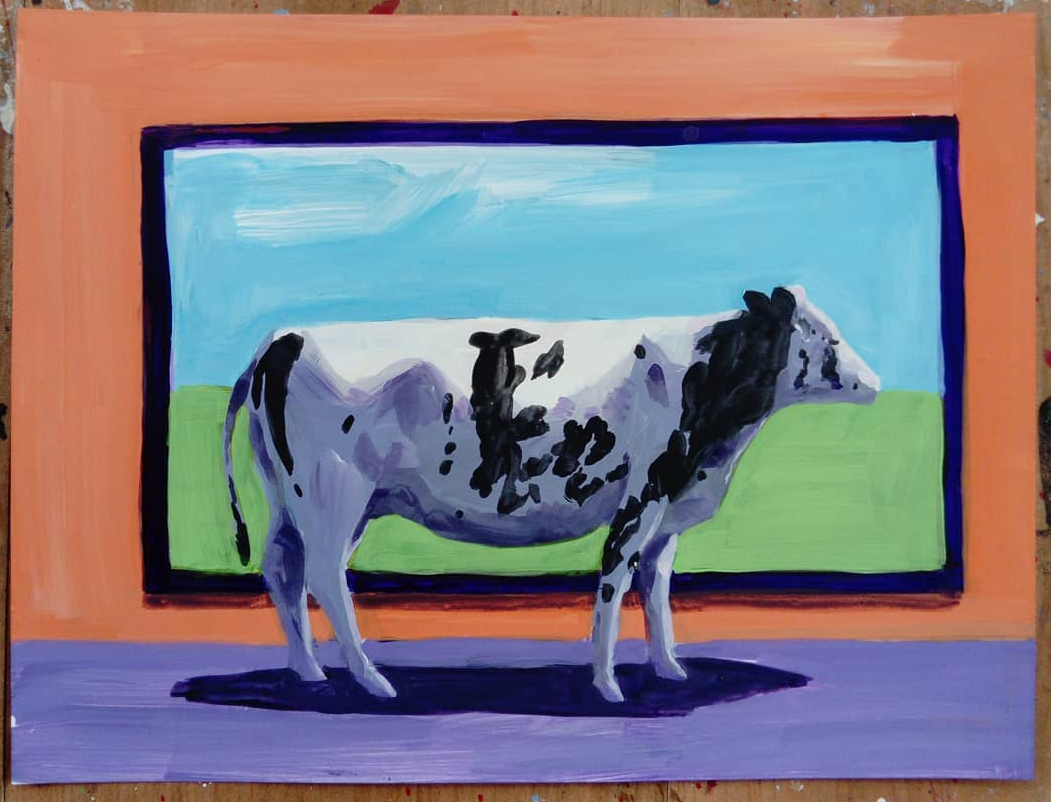
He painted all day. His eyes felt tired. I can’t be sleepy, he thought, not realizing that today he was in such a focus that he had blinked less than a baby. He closed his eyes trying to squeeze out some lubrication, and then opened them while stepping back.
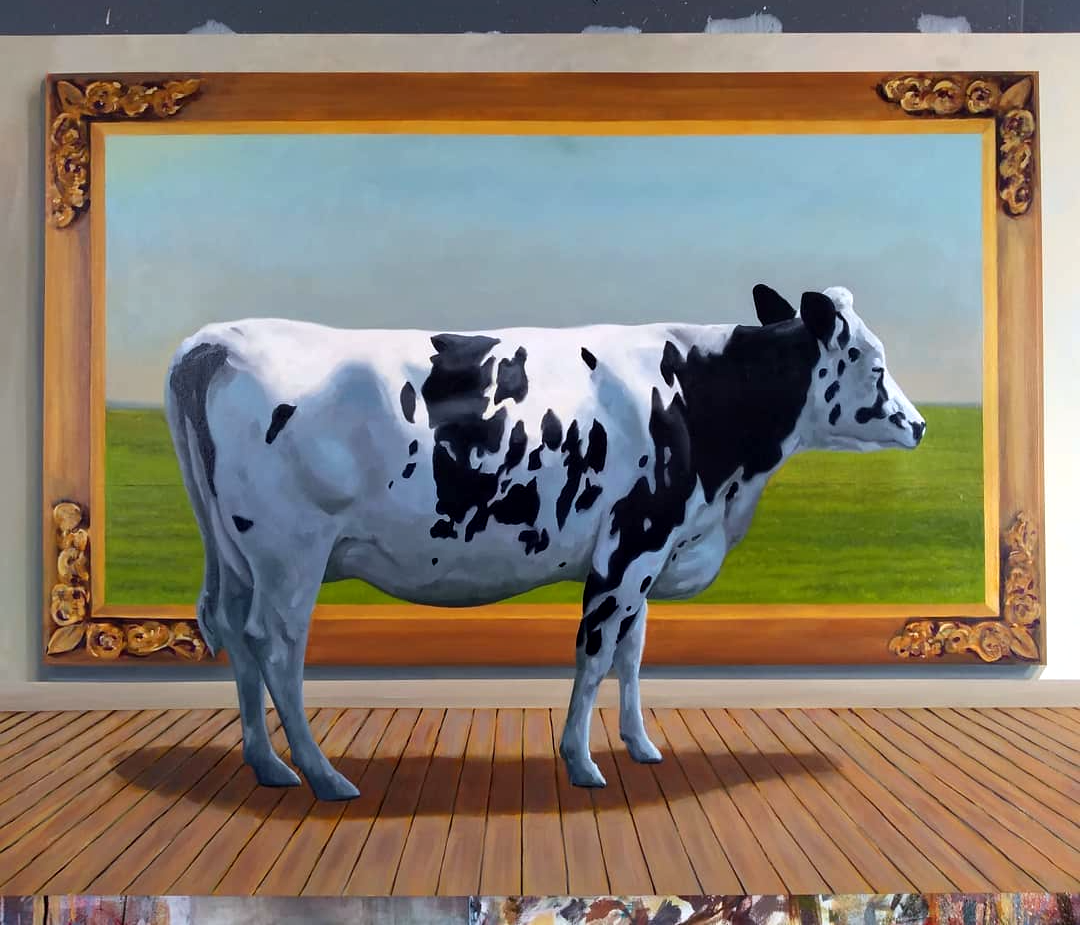
He took a photo of the painting and walked to a cafeteria that had closed hours ago, and sat on the stairs. When he noticed the sub-painting horizon he said: “Sorry, my little cow.” In an app, he previewed a few color adjustments and headed back for the final touches.
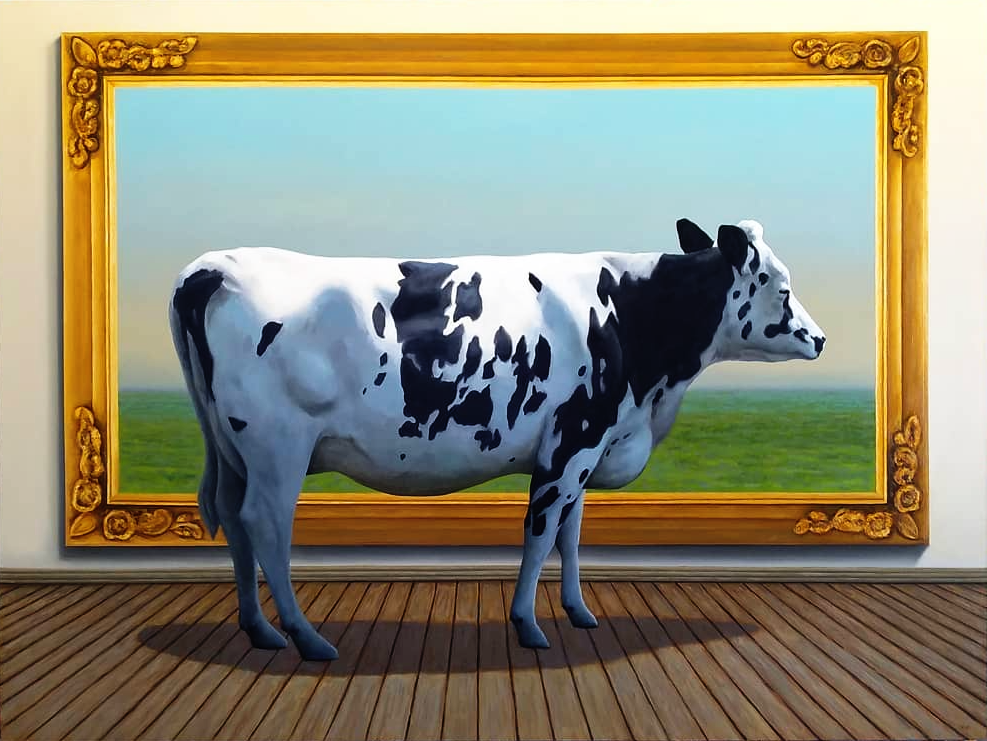
He finished the adjustments and grabbed the painting – not like a masterpiece but like a shield – and headed to the teacher’s office.
The teacher looked at the painting and while getting closer to it said: “Cesar… sign it.”
Cesar headed back to the classroom imagining how his signature would look on the painting, but when entering, he noticed at a distance that Melissa was staring at her painting in frustration. He knew the worst he could do at that moment was to rub out his A by signing the painting. So instead, he put his brushes in mineral spirits and went to her. “Tell me,” he said.
“She needs to be illuminated by a red light.”
As Cesar saw no hint of such light he said: “Glaze it.”
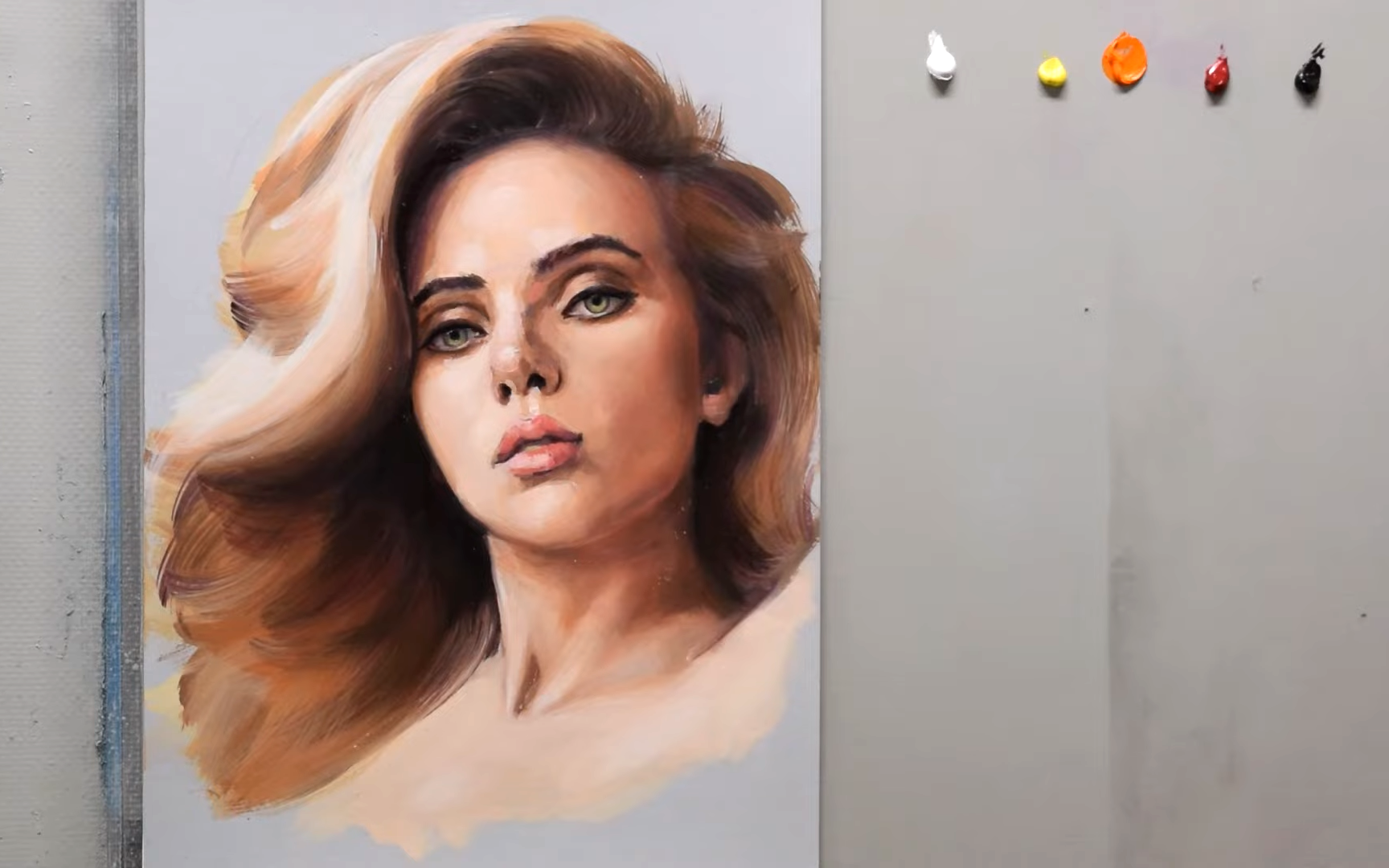
“What’s that?”
“It’s easier if I show you.”
“OK.”
He grabbed two heat guns from a drawer.
“No! It’s going to crack the paint,” she said.
He knew the teacher wouldn’t mind cracked paint, but he said: “Not if I heat it from the back.”
“Don’t melt it.”
“Take this one; hit it from the front.”
When it had dried, he started glazing it.
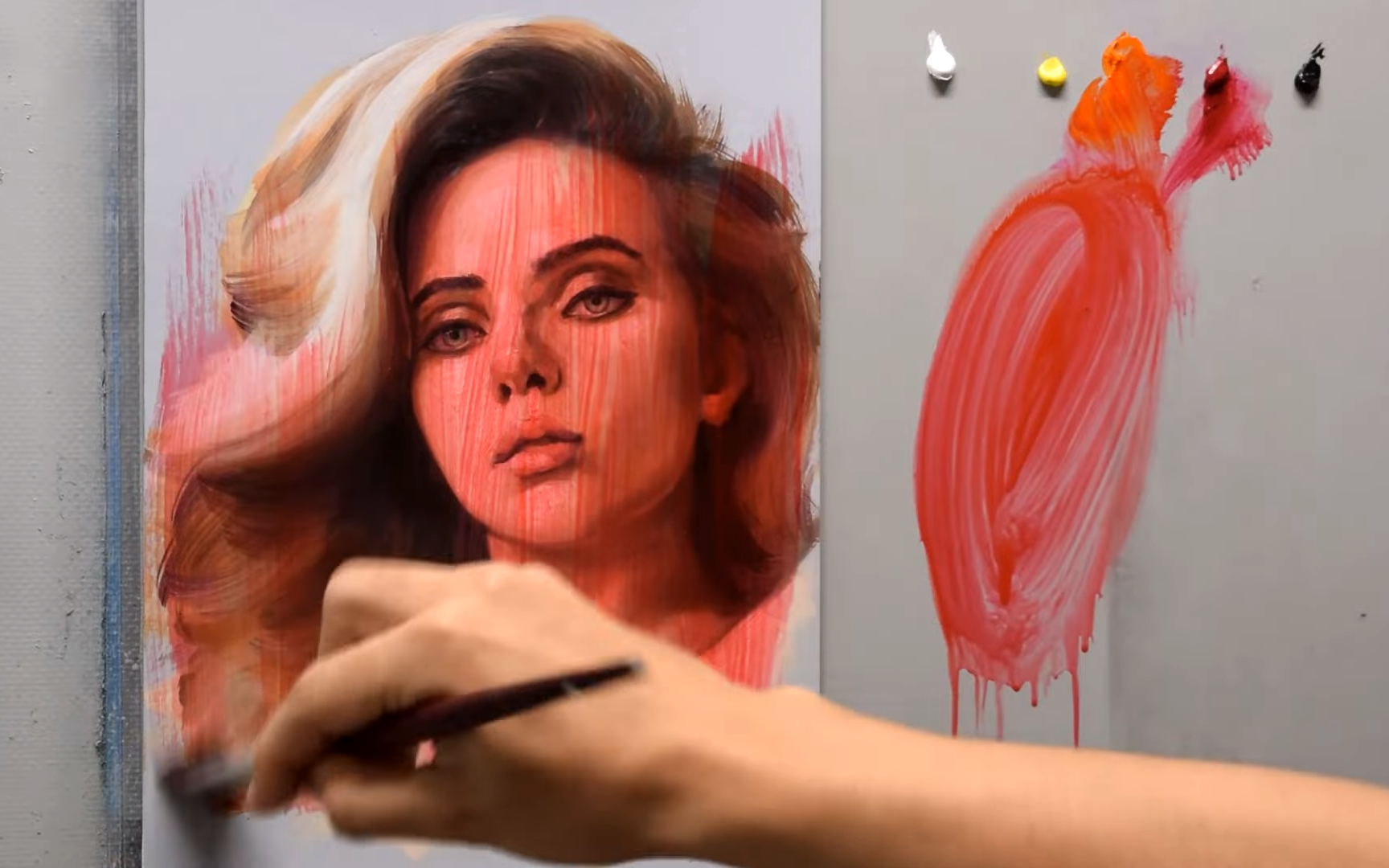
As soon as she saw her painting ruined in red, she left the classroom, and without looking back, she screamed, “Envy!”
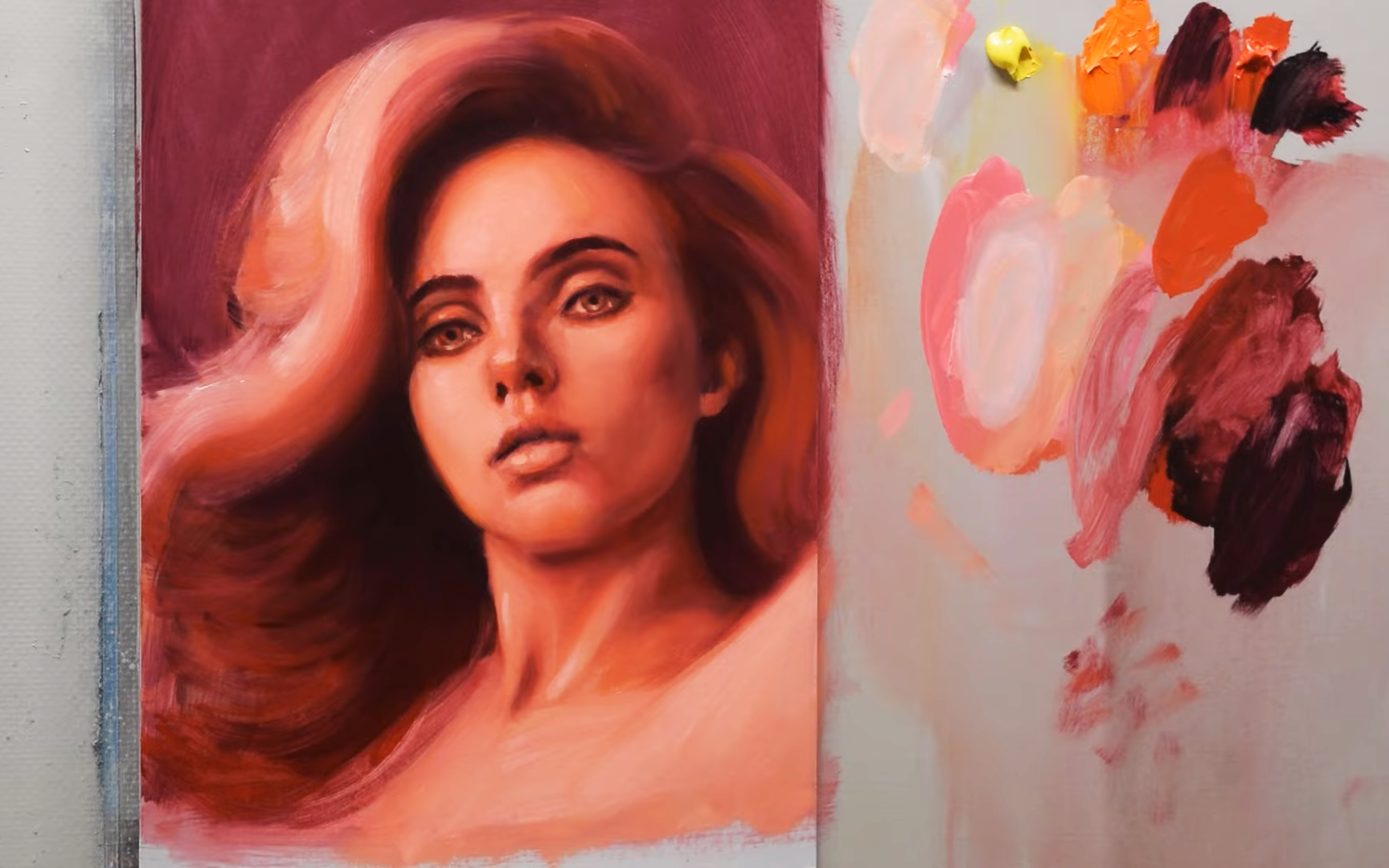
She never saw the result.
Years later, Cesar became a teacher as well. On the first day of class, his students have to draw from an upside‑down reference. He explains:
“We all have preconceptions. We form opinions without adequate knowledge. Drawing is no different. When we draw an ear, we think we already know how it is. We’ve drawn many, but we’ve seen few.
“By drawing upside down you will learn a way to stay to true to form. Outside class, you may trace with any technological aid you wish. From light chambers to augmented reality overlays, you name it.
“Is that cheating…? No, it’s not. Painting is not skill-bragging.
“Outside, you’ll also decide if your paintings stay true to form. That’s your choice. But it’s not a choice if you can’t draw.”
The End
Based on a true story. You can listen to Cesar Cordova telling it while drawing the girl in his YouTube video: The Reason Why You Should Destroy Your Work.